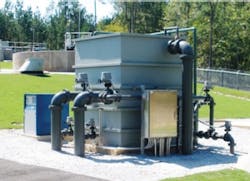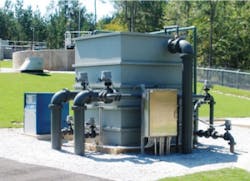Hydroelectric Plant Project Team Selects HDPE Pipe
Hydroelectricity has been used in Canada for more than 100 years and today represents nearly two-thirds of the country’s power generation . While hydroelectric power is not a new concept, using large diameter high density polyethylene (HDPE) pipe to transport water from a source to the generator is relatively new and is helping increase efficiency standards in construction and operation.
At the Wawaitin Generating Station on Kenogamissi Lake near Timmins, Ontario, Ontario Power Generation (OPG) is conducting a total reconstruction of its hydroelectric plant including the piping system responsible for transporting approximately 40 cubic meters of water per second through the plant which generates 10 MW of electricity. Including the Wawaitin Generating Station (GS), OPG has a total capacity of more than 21,000 MW of electricity, making it one of the largest power generation companies in North America. The entire Wawaitin station is at the end of its service life and is being rebuilt. The new plant will generate 15 MW of electricity, which is enough to power approximately 15,000 households.
The original piping system at the Wawaitin GS site used different types of traditional materials, including wood stave and steel. Several different materials for the large diameter pipe were considered to transport water from Kesogamissi Lake to the plant. The original design was based on using concrete pipe with a transition to steel to accommodate the higher head pressure closer to the powerhouse. However, cast-in-place concrete requires a lot of man hours to install, can be expensive to maintain and repair, and the rebar used in construction can corrode and cause other problems. .
With this in mind, Kiewit-Alarie, A Partnership (KAP) made the decision to change the original design to replace the concrete portion with a pipe made from HDPE resin. The specific pipe chosen was Weholite, which Kiewit had used before on other hydropower projects in British Columbia.
Weholite is a large diameter, profile wall piping product designed for gravity and low-pressure applications. The pipe combines the raw material properties of HDPE with patented structural wall technology to create a lightweight engineered pipe with excellent loading capacity. KWH Pipe manufactures Weholite using DOW™ DGDB-2480 NT HDPE resin, a PE3608 resin that offers properties such as stress crack resistance, salt water and chemical resistance, cold temperature toughness and the opportunity to create a leak-free piping system through thermal extrusion welding joining methods. The pipe can be made in lengths of up to 50 feet and inside diameters up to 132 inches.
Weholite has been used in many municipal and industrial applications including new pipeline and pipeline rehabilitation projects and offers substantial savings in weight for increased ease of installation and cost effectiveness. This was a key factor in KAP’s decision to include approximately 3,100 feet of 132 inch inside diameter Weholite pipe in two parallel lines, according to Paul Mongelli, Site Engineer with Kiewit at the Wawaitin Generating Station Project.
“This is our first design/build project with OPG,” said Mongelli. “We did our homework and decided against using concrete due to several construction and operational benefits of HDPE. The Weholite pipe can be installed in less man hours with less equipment so there was a significant cost savings during construction. It also offers OPG some nice benefits once the plant is up and running.”
“The ability to extrusion weld joints is a tremendous benefit of HDPE pipe,” Mongelli said. “We can typically weld one to two joints per day resulting in a much improved timeline for this part of the project. And, there’s no building forms, pouring concrete or drying time. The ability to extrusion weld the joints greatly reduced the time and manpower needed for the project.”
According to the Plastic Pipe Institute, HDPE’s heat-fused or extrusion welded joints create a leak free, self restraint, monolithic pipe structure; the welded joint will also eliminate infiltration into the pipe and exfiltration into the environment. Maintenance benefits also made HDPE a solid fit for the Wawaitin Generation Station.
“We anticipate zero maintenance costs with the HDPE pipe,” said Bruce McIvor, Site Representative with OPG.
In addition to the facility coming to the end of its service life, OPG is replacing the generating station because of an 18% energy loss with the system due to the 300 km of transmission lines the power must travel to get to the grid.
“The new system will change the generating station from 25 to 60 Hz allowing connection directly to the local distribution system eliminating the need to transmit the energy from Timmins to Sudbury. This change will eliminate significant energy losses and free up a transmission corridor,” McIvor said.
“By refurbishing, upgrading and expanding our hydroelectric capacity across the province, we are diminishing our reliance on burning coal for fuel and plan to stop burning coal altogether by the end of 2014. OPG is committed to reducing our carbon footprint through projects like this one and enjoy the opportunity to work with companies like KWH and Dow which have similar corporate goals,” McIvor said.
Past IWW Issues

